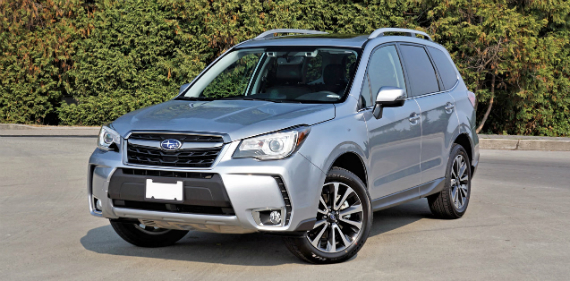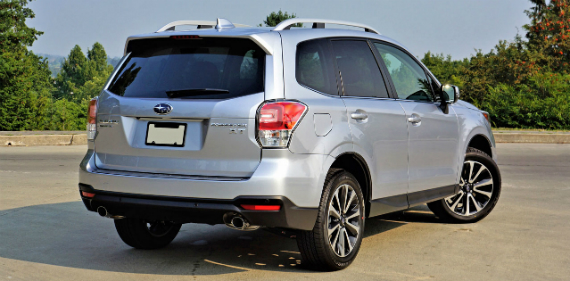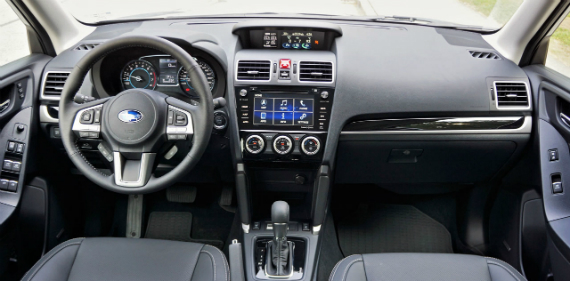2018 Subaru Forester 2.0XT Touring

Continual improvement makes the Forester one of the best in its class
Subaru’s Forester has come a long way since a funky squared-off, raised wagon by the same name debuted in 1997. That model did well for the brand and helped to usher in the compact crossover SUV craze, but in 2002 the hard edges were smoothed out, refinements improved the cabin, and soon after a version of the WRX STi’s turbo-four was added to a new top-line XT trim that pumped up performance. The Forester grew up to true compact SUV dimensions in 2008 for the 2009 model year with the release of its third-generation, while 2013’s fourth-gen model, followed by its mid-cycle upgrade last year, returned some of its edgy, chunky original design elements, albeit in a larger more upright utility.
I’ve just scratched the surface of the many changes that joined those updates, plus numerous modifications in between, to the point that today’s Subaru is so far advanced over its predecessors it might as well be an entirely different SUV. Of course, the same can be said of many popular cars and sport utilities currently available, but Subaru’s slow and steady embrace of the mainstream market, while still holding true to key elements of its idiosyncratic past, is wholly unique.
First off, while the Forester originated as more crossover than SUV, it now appeals to more dyed-in-the-wool SUV fans that have somehow been forgotten in a near global shift to car-based utilities. With many of its rivals becoming ever sleeker in their quests for more sport in the SUV equation, Subaru stays confidently upright in the Forester’s styling, as if it’s somehow capturing a lost youth it missed out on the first time around. As a fan of serious 4x4s from Land Rover’s original Series I and Defender to Toyota’s Land Cruiser FJ and BJ70, not to mention Mercedes’ Geländewagens old and new, I’m subconsciously pulled toward the Forester’s more classic SUV lines, which were beefed up considerably for its 2017 refresh and get even more pronounced ruggedness when moving from the base 2.5i engine to the 2.0-liter turbo XT.
Yes, Subaru still uses its XT nomenclature, and both the 170 horsepower naturally aspirated base 2.5-liter engine with 174 lb-ft of torque, and the 250 horsepower direct-injected 2.0XT powerplant with 258 lb-ft of torque, which is one of the most powerful in the mainstream compact SUV class, are formed from the brand’s iconic horizontally opposed four-cylinder “boxer” design. This “H” engine lineup, which even includes a larger 3.6-liter H6 in Subaru’s Legacy and Outback, has been enhanced for refinement and fuel economy over the decades, with the Forester’s 2.5i good for an EPA claimed 22 mpg city, 28 highway and 24 combined rating with its base six-speed manual, or 26 city, 32 highway and 28 combined with its optional automatic, a smooth and efficient continuously variable transmission (CVT) that goes by the name of Lineartronic, while this 2.0XT, which comes standard with the CVT, is rated at just 23 city, 27 highway and 25 combined.

As you may have noticed I haven’t included FWD and AWD fuel economy comparisons, which is due to Subaru supplying all Foresters, as well as most every other vehicle in its ever-growing lineup, with standard all-wheel drive. No other vehicle in the mainstream compact crossover SUV class can say the same, not even Jeep. What’s more, Subaru’s unique engine design, which can be laid lower in the chassis to in-turn lower the Forester’s overall center of gravity for improved handling, also frees up space to allow for a better designed four-wheel drive layout dubbed Symmetrical AWD. As the name implies, Symmetrical AWD applies evenly distributed torque to each drive wheel. Full-time four-wheel motive power also reduces front-end lift and rear-end squat at takeoff, which would otherwise upset overall balance. Not a problem for the Forester.
The result is a compact SUV that inspires confidence in the kinds of slippery conditions that many Americans have been suffering through so far this winter. Along with the added inclement-weather grip, the Forester’s AWD aids stability in all weather conditions, even dry, improving high-speed handling for better performance whether on pavement or gravel, while ride quality remains comfortable for the class.
For those truly non-sticky situations, such as after a rainfall on a muddy backcountry road or when trudging out from a knee-high snow drift that forces most everyone else to get out and strap on chains, merely press the large silver “X MODE” button ahead of the Forester’s shift lever to engage Subaru’s unique off-road setting. It allows the engine, transmission and traction control modules to work in unison for real 4x4 capability, by applying even torque to all four wheels and not allowing those without grip to spin, which leaves you to simply add throttle and steer. X Mode stays engaged until your Forester passes the 25-mph mark, at which point it disengages and all systems return to normal.
All of this advanced driving kit might sound as if it’s connected to a rugged, truck-based SUV, but today’s Forester is based upon Subaru’s well-proven small car platform architecture that also underpins the previous-generation Impreza and Crosstrek (Subaru’s new scalable, modular Global Platform won’t impact the Forester until a complete redesign arrives for 2019). This means it’s a rigid, lighter weight unibody design that also provides more room inside than traditional SUVs.
Yes, the Forester is spacious. Most anyone should fit comfortably up front, the 10-way powered driver’s seat, which comes standard on everything above the base model, providing ample adjustment including powered lumbar support, and the tilt and telescopic steering column capable of long enough travel to satisfy those with slightly shorter torsos/arms than legs, like yours truly.

When the driver’s seat was set up for my five-foot-eight medium-build frame I found the second-row seat just behind roomy enough too, with about eight inches ahead of my knees, plenty of space for my feet while wearing boots, and another four inches above my head, while air space between body and door panels never made my shoulders and hips feel congested. Three adults abreast wouldn’t be an issue, but you get the comfort of a nice, wide flip-down center armrest with integrated cupholders if only two are in back. Parents will appreciate new for 2018 child seat anchors across the entire Forester line, which are reportedly easier to use.
The tall side windows and large panoramic sunroof overhead gave my Touring model an airy greenhouse effect, this trim line particularly well-equipped with 18-inch machine-finished alloys, steering-responsive auto on/off LED headlights, fog lamps, proximity-sensing keyless access with pushbutton ignition, a heatable leather-wrapped steering wheel, heated side mirrors, windshield wiper de-icer, an electroluminescent primary gauge cluster with a color TFT multi-function display, dual-zone auto climate control, very accurate navigation with detailed mapping, a superb sounding eight-speaker Harman/Kardon audio system with a 440-watt eight-channel amp, plus leather upholstery, two-way heated seats, two-position driver’s seat memory, a powered tailgate with memory height function, one-touch folding rear seatbacks, side/rear vehicle detection, and more, all for $33,090 plus freight and fees with the 2.5i powertrain and $36,090 with the 2.0XT.
The sunroof actually gets pulled up from lesser Premium trim, which starts at $25,695 in the 2.5i and $29,495 with the 2.0XT, this model also adding its roof rails and rear rooftop spoiler to Touring trim, plus a 0.8-inch larger 7.0-inch infotainment system featuring a premium quality high-resolution touchscreen with tablet-like multi-gesture tap, swipe and pinch capability, an upgraded Subaru StarLink apps and services bundle, Siri Eyes Free, MirrorLink smartphone connectivity, powered driver’s seat, reclining rear seatbacks, and a stainless exhaust tip, while along with the Forester’s $22,795 base model adds a 4.3-inch color multifunction display atop the dash, filtered air conditioning, a backup camera (albeit with dynamic guidelines all the way up to Touring trim), Bluetooth with audio streaming, StarLink smartphone integration with Pandora, iHeart Radio, Stitcher, Aha radio, HD radio, a USB port/iPod interface, aux input, satellite radio, the usual active and passive safety features including an airbag for the driver’s knees, etc.
It’s not until moving up to the sportier 2.0XT powertrain that the sportier looking front and rear fascia designs become standard fare, not to mention an intercooler duct added to the hood, dual stainless exhaust tips, yet more metal brightwork decorating the exterior, larger 12.4-inch front and 10.9-inch rear brake rotors, a re-tuned sport suspension with chassis bracing, and a high-torque CVT with steering wheel-mounted paddles.

Touring trims come standard Subaru’s advanced EyeSight package that’s also available with Premium models and a 2.5i Limited trim I’ve yet to mention as it’s not available with the 2.0XT powertrain. EyeSight includes steering responsive fog lamps (with Premium models only), adaptive cruise control, pre-collision braking, pre-collision brake assist, pre-collision throttle management, lane departure warning, lane keep assist (which functions over a wider speed range for 2018), lane sway warning, lead vehicle start alert, and reverse automatic braking, while the Touring with EyeSight gets exclusive automatic high beam assist.
My tester’s auto-dimming rearview mirror came from the accessories catalog, and yes it’s strange they don’t just include it with Touring trim, while you can also get auto-dimming side mirrors among the plethora of available accessories as well, with approach lights no less.
Subaru has done a good job of gentrifying its Forester over the years, with this latest model the most refined yet. This includes reduced noise, vibration and harshness levels as part of last year’s update, while it also gets a fully padded soft synthetic dash top that folds over the top half of the instrument panel and all the way down each side of the center stack, the lower portions of which appear like handles with stylish perforated pleather and metallic detailing. Glossy piano black lacquer and metallic trim spans from just left of the driver, across the instrument panel to the right door, while nice satin-silver detailing trims the door panels that are also finished with contrast stitched armrests, perforated leatherette inserts and door pulls, plus soft uppers.
The aforementioned leather-wrapped steering wheel rim is thickly padded, and therefore feels both sporty and comfortable in the hands, while the shifter is clad in leather as well, plus features a contrast-stitched leather boot. Perforated leather covers the seats, except for the bolsters that are finished in solid leather with contrast stitching.
Ahead of the driver is an analog dual-dial primary gauge setup with a large color multi-information display at center, although this latter items is more of a trip computer than a full multi-information display. Rather, the complete MID sits overtop the center stack, providing a color analog-style digital clock, an exterior temperature readout, an average mileage indicator, HVAC info, and more. You can delve deeper into the system for fuel economy and range info, which includes detailed graphs for immediate and average fuel economy, a tire pressure graphic, IG sensor graphic, and more.

I’ve already gone over much of the infotainment system’s features, so suffice to say it’s a very good up-to-date design that’s easy to operate thanks to touch-sensitive buttons down each side for accessing the home screen, map and navigation, apps, info, plus forward and reverse seek/track, while simple yet elegant metal dials allow for audio volume and tuning control. Just below, Subaru circles each of the dual-zone auto HVAC interface’s three rotating dials with nicely knurled metallic grips, while a glossy black background benefits from brightly colored temperature indicators. It’s a really good-looking design, as is the entire center stack.
This can be said of the overall interior too, with even the cargo compartment finished fairly well for this volume-branded class. The powered tailgate is painfully slow to open or close, although on the positive it doesn’t resist if you’d rather do so manually, while my tester’s cargo floor was protected with a fitted rubber tray, a good way to keep the carpet underneath looking new for the life of the car. That load floor features chromed tie-down hooks at each corner and a hinged floor that lifts to expose a removable styrofoam compartment for stowing oily rags and/or valuables, this sitting atop the spare tire.
Cargo capacity measures 25.6 cubic feet behind the rear seats and under the retractable cargo cover, 34.4 cubic feet when factoring in the area above the cargo cover, and 74.7 cubic feet when the 60/40 split rear seatbacks are lowered. This said the rear subwoofer eats some gear-toting space away from Touring models, which only provide 31.5 cubic feet behind the rear seatbacks and 68.5 cubic feet when they’re laid flat. In order to lower them, you can either unlatch them via organ stop-style pulls atop the seatbacks, or release them with levers on each cargo area sidewall, at which point they fall completely flat.
At the other end of the Forester is the aforementioned scoop-adorned aluminum hood, and while I don’t normally comment on engine covers, the Forester 2.0XT’s is particularly nice. I like seeing this level of detail under the hood, as it shows Subaru’s pride in this uniquely impressive power unit. Along with some nice louvers and a bright silver “SUBARU BOXER DIT” plaque, a large grated-silver opening provides access from the forced air above. Only a quad of downdraft Webers would look better, but of course that’s only a whimsically misguided thought from a vintage fanatic.

It’s these small yet thoughtful details that make the Forester 2.0XT Touring special, and in my opinion lifts it above many of its compact SUV peers. Subaru even went so far as to improve the seatbelt reminder alert for 2018, a model that won’t be with us for much longer. That said the price of this model with surpasses $36k plus freight and fees. Fortunately there’s no extra charge for any of its seven exterior color choices, or for that matter its black or brown interior themes, but the Forester is entering compact luxury SUV territory either way.
Yet that’s ok. Subaru is one of few mainstream brands that have managed to develop some real premium cachet, this achieved by sticking true to their engineering principles while delivering superior performance both on and off the road, impressive interiors with leading edge electronics, impressive comfort and convenience features, plus top-tier advanced driving assistance systems. For these reasons and more, Subaru has enlisted a large, loyal following that appears to be growing with every passing year. I recommend you take a close look at a Forester if you’re in the market for a compact SUV, as you’ll likely appreciate what you find.
Story credits: Trevor Hofmann, American Auto Press Photo credits: Karen Tuggay, American Auto Press Copyright: American Auto Press
